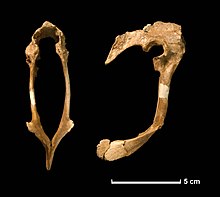Hesperonychus
| Hesperonychus | |
|---|---|

| |
| UALVP 48778, holotype pelvis | |
| Scientific classification | |
| Domain: | Eukaryota |
| Kingdom: | Animalia |
| Phylum: | Chordata |
| Clade: | Dinosauria |
| Clade: | Saurischia |
| Clade: | Theropoda |
| Family: | †Dromaeosauridae |
| Clade: | †Microraptoria |
| Genus: | †Hesperonychus Longrich & Currie, 2009 |
| Species: | †H. elizabethae
|
| Binomial name | |
| †Hesperonychus elizabethae Longrich & Currie, 2009
| |
Hesperonychus (meaning "western claw") was a small,
Description
Hesperonychus is known from one partial
Classification

A
Hesperonychus was assigned to Microraptoria due to having a spatulate (rounded) pubic symphysis, a strong posterior curvature of the distal shaft of the pubis, and lateral tubercules on the pubes (which are expanded into 'wing-like' structures in the case of Hesperonychus).
Cladogram (2012):[5]
| Dromaeosauridae |
| |||||||||||||||||||||||||||||||||||||||||||||||||||||||||||||||
Paleobiology
Microraptorines are well known for their small size and, in some cases, ability to fly or glide. Longrich and Currie concluded that it was unlikely for Hesperonychus to exhibit four wings or gliding behavior as in Microraptor, and speculated that it was more likely to be similar to Sinornithosaurus given their closer similarity in size. Nevertheless, Hesperonychus seems to show that microraptorines did not vary much in size, remaining very small relative to other dromaeosaurids throughout their history.[2]
Aside from extending the known range of microraptorines, the discovery of Hesperonychus filled in a gap in the ecology of Late Cretaceous North America. Unlike roughly contemporary environments in Europe and Asia, North America appeared to lack very small carnivorous dinosaurs. In modern ecosystems dominated by endothermic mammals, small animal species outnumber larger ones. Since dinosaurs are also presumed to have been endotherms, the lack of small species and great number of known large species in North America was unusual.[2] Hesperonychus helped to fill that gap, especially since, given the number of fragmentary remains and claws that have been collected (representing at least ten distinct specimens, compared to thirty of the contemporary Saurornitholestes and two of Dromaeosaurus), it appears to have been a very common feature of the Dinosaur Park Formation environment.[2]
The next smallest carnivore in the environment was the mammal Eodelphis, which weighed only 600 grams. There does not appear to have been any overlap between the smallest dinosaurs and the largest mammals in ecosystems such as this, which Longrich and Currie explained by hypothesizing that either competition from dinosaurs kept mammals from growing larger (the traditional view), competition from mammals kept the dinosaurs from growing smaller, or both.[2]
See also
References
- ^ Alberta researchers discover mini meat-eating dinosaur, a 16 March 2009 article from CBC News
- ^ PMID 19289829.
- OCLC 985402380.
- ^ Canadian dig yields tiny dinosaur, a 16 March 2009 article from BBC News
- PMID 22615813.


